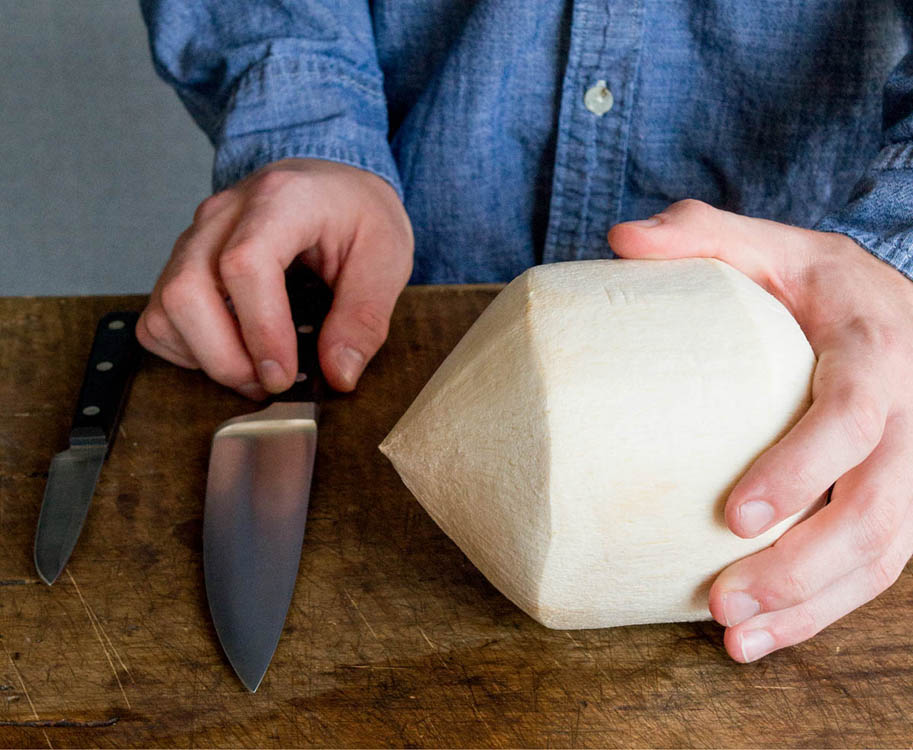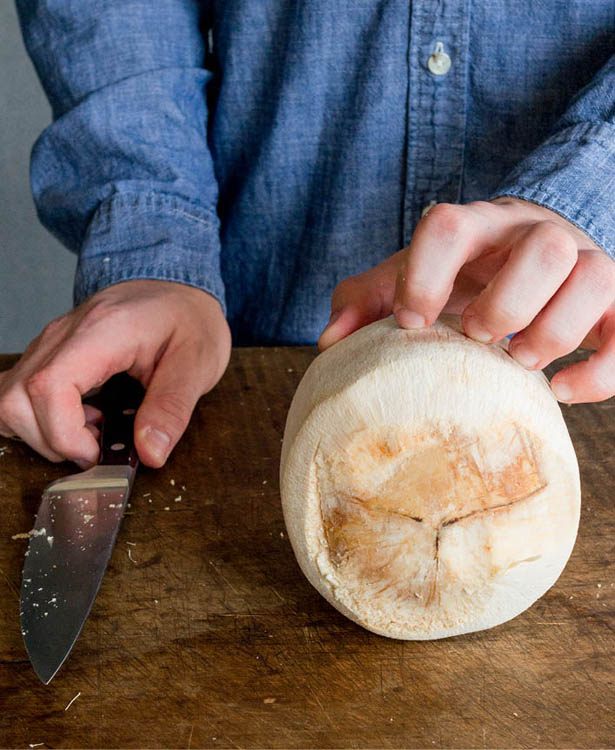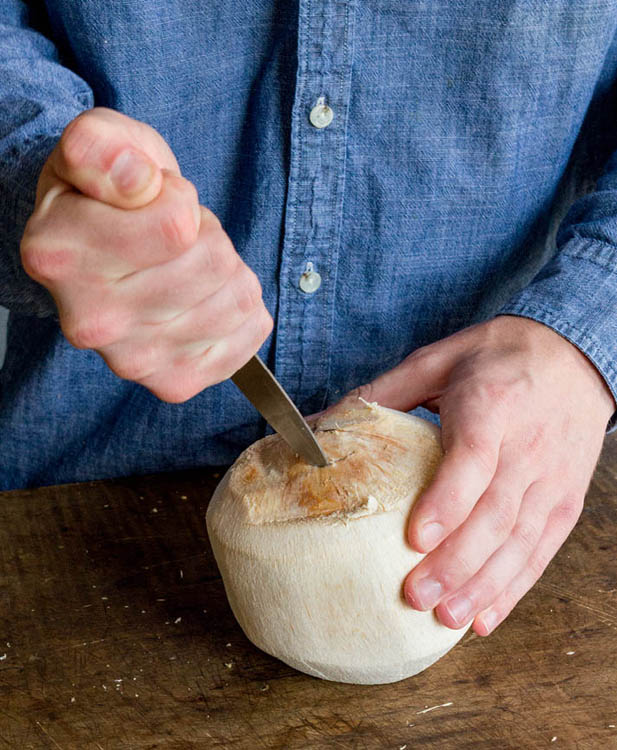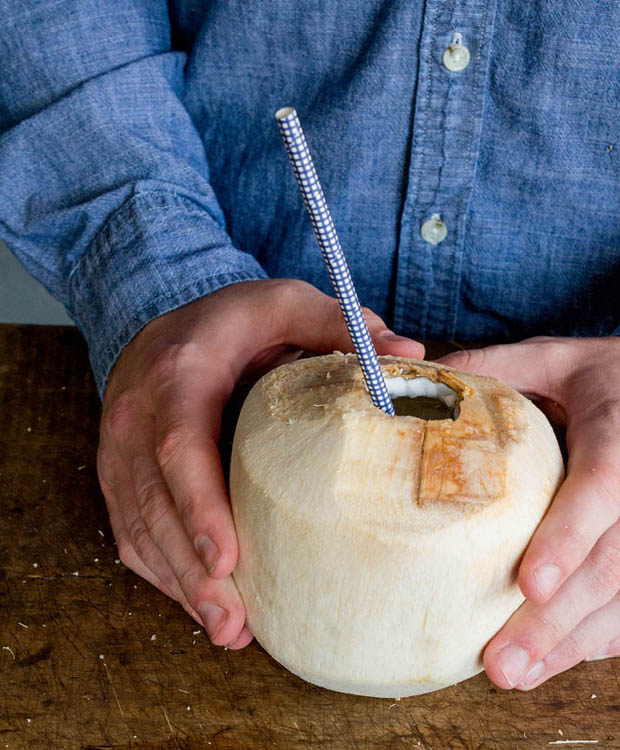
The box grater lived in the back of my parents’ kitchen cupboard, behind the pots and pans. It sat tucked next to my father’s favorite hand-hammered metal dish that my mother had brought from her native Iran, which he used solely for marinating chicken and meats in his Trinidadian curry powder. Dented and dull, the grater had one purpose: to rend and score the hard white flesh of the coconut that my father would crack open with a sharp machete.

We were more accustomed to coconut than other folks in our neighborhood. To most, it was an exotic rarity, the stuff of Mounds bars or, occasionally, a Sara Lee cake. But my Caribbean father used coconut in his breads, tarts, and “sugar cakes” — the candies he sometimes made from boiled sugar and coconut — as well as in curries, soups, and stews. My father’s baking days only happened a few times a year, but they gave me a taste and a passion for coconut’s wonderful flavor, a passion that only grew on visits to his home country of Trinidad. There, coconut is the “vanilla” of the land, the base flavor of cookies, cakes, candy, ice cream, rice pudding, drinks, and a few savory dishes, too. In short: heaven.
My love for coconut remained steadfast and true, even in the face of avowed coconut haters. And, oh, they were many. To them, coconut was an odd artificial flavor, reminiscent of what tanning oil might taste like if they cared to try it. Little did I know when I was a child that coconut would become one of the biggest food trends in decades. Today it has exploded onto the American culinary scene and captured the taste buds and imagination of eaters and cooks everywhere.
The coconut products available today are incredibly varied and diverse. Not only are there numerous types of coconut-based products, but there are also multiple companies offering them. Even the most mainstream American food companies have begun selling coconut products. This chapter provides a primer on each of these products.
Coconut is one of the most versatile plants in existence and one from which an astonishing variety of products is manufactured. The fruit, the plant fibers, and the tree sap are all processed and used in multiple ways worldwide. Modern technology has taken that diversity a step further with products that make this tropical fruit not only readily available around the world but ingeniously adapted to modern lifestyles.

green coconuts
Coconut water is the liquid center of the coconut. It is more abundant when the coconut is young or “green” and less so the more mature the coconut gets. The tastiest coconut waters for sale in cans and bottles are from sweet, young coconuts. Mature coconuts do not provide a fresh-tasting water. Powdered coconut waters that can be reconstituted with pure water are increasingly available. In cultures where coconut is prevalent, the water is often used as an electrolytic drink to prevent dehydration.
Most commercial coconut waters are pasteurized to remove any bacteria, although there are a few raw coconut water brands — including Harmless Harvest — that employ pressure treatment to remove microcontaminants, and these require refrigeration to retain freshness. Raw coconut drinks are more perishable than their aseptically packaged counterparts, so pay attention to the “sell by” or “use by” dates when buying these products, just as you would for animal milk products or fresh juices.
Coconut milk is perhaps the most misunderstood product that comes from the coconut. It is not the liquid inside of a coconut, as many believe (that’s coconut water), but the coconut “meat” puréed with water into a smooth liquid. The less water used, the thicker and creamier the coconut milk (see description of coconut cream).
You can easily make coconut milk at home (see the recipe) with fresh, frozen, or dried unsweetened coconut meat.
It’s worth noting that commercial coconut milk comes in several varieties and that, even within a single variety, different manufacturers’ products can vary in consistency and taste.

Coconut milk is not the liquid inside of a coconut, as many believe (that’s coconut water), but the coconut “meat” puréed with water into a smooth liquid.
As impressive as the amount of food products that come from the coconut palm are, equally astounding is the multiplicity of uses for the other parts of the tree. The trunk, for instance, is used to make furniture and buildings, as well as canoes, containers, and drums. The roots are used for making dyes, mouthwash, and even toothbrushes. The leaves make bags, baskets, brooms, toys, umbrellas, and much more. Because of this, many ancient coconut-producing cultures considered the palm necessary for survival and sustenance. Often, a young coconut tree is given as a wedding gift to a newly married couple setting up their own home to provide them all they need for a successful future. The coconut palm well earns its title “Tree of Life.”
Coconut nectar is made by tapping a coconut palm, much the way a maple tree is tapped for sap to make maple syrup. The sap that runs out of the coconut palm is heated at a low temperature to thicken it. The resulting syrup has a texture that is similar to that of honey or agave syrup. This dark nectar does not have an overtly coconut taste, but it is a sweetener with a low glycemic index.
Also called coconut butter or coconut spread, coconut manna is puréed dried unsweetened coconut meat. During the puréeing or grinding process, the coconut releases its natural oils, which allows the coconut meat to be puréed into a thick paste that has the consistency of butter. Coconut manna is used as a spread in place of cow and nut butter and can be sweetened or flavored during the puréeing process as desired. Coconut manna can be made at home, but it requires a high-powered blender like a Vitamix (see the recipe). Like other butters, coconut manna melts easily and can be used as a liquid application.
Coconut flour is made from defatted coconut meat that is dried and ground into flour. It is derived from the solids left over after the process of making coconut milk.
Coconut flour cannot be substituted for all-purpose flour or other grain flours on a 1:1 basis. The main reason for this is that coconut flour absorbs a great deal of liquid. A good rule of thumb is to substitute one-quarter to one-third of the grain flour a recipe calls for with coconut flour and use two to three times the amount of baking powder or yeast if the recipe calls for either. Another good tip is to increase the amount of eggs if the recipe calls for them: generally, six large eggs for 1 cup of coconut flour is about right. When using coconut flour for dredging items for frying, you can simply use it as you would use grain-based flour; however, make sure to sift the flour first, as it can get clumpy.
A popular sugar substitute because of its low glycemic index, coconut sugar is, like coconut nectar, a sap-based product of the coconut tree. The heavy branches that hold the coconut blossoms, later to become mature coconuts, are tapped for the milky white sap they hold. This sap is boiled at a low temperature, past the point necessary to make coconut nectar, until it granulates. Except for the level of heat applied, making coconut sugar from sap is similar to the process of turning cane juice into granulated sugar or making maple sugar out of maple syrup.
When coconut-blossom branches are tapped to make sugar, the process effectively drains the nutrition from the budding coconuts. As a result, you can’t have both coconut sap/sugar and mature coconuts from the same tree. Like the coconut itself, coconut sugar is very high in minerals like iron, zinc, potassium, nitrogen, and others, while plain white refined cane and beet sugars have virtually no mineral content.

Like the coconut itself, coconut sugar is very high in minerals like iron, zinc, potassium, nitrogen, and others.
Rarely seen outside of the countries in which coconut is grown, sprouted coconut is the spongy interior of the coconut after it has dried past the point of having any meat left. The sponge feeds the growth of a new sprout, which will ultimately become another coconut palm. This sponge or sprout is edible and has an intense coconut taste with a spongy or sometimes cotton candy–like texture.
Toddy (also called tadi) is the sap of the coconut palm. It can be consumed immediately as a beverage or aged in a process that produces vinegar. Various toddy vinegars are available on the market and can be used in the same way as fruit vinegars: for salads, marinating meats, ceviches, and medicinal purposes.
The sap can also be fermented and distilled into a strong alcoholic drink that, at times, has been banned in the various countries in which it is produced. Toddy liquor production in places like India, for example, is akin to backyard moonshine production in the United States. In the Philippines, coconut liquor is often called “coconut arrak” or “coconut vodka” and is a commercially produced beverage.
Most coconut products are high in fat, so rancidity can definitely be a problem. A good rule of thumb is to refrigerate any wet or moist product such as coconut milk, coconut water, or shredded coconut meat and to store any dry product such as desiccated coconut, coconut flour, and coconut sugar in an airtight jar. Label the jar with the date and discard any products after 2 months to ensure the freshest taste.
For centuries, cultures worldwide have processed coconut into its various forms by hand or by using simple technology. Today, aided by modern kitchen equipment and the abundance of coconut now available, you can easily make many of these products at home.

Opening a young Thai coconut
Getting to the heart of this wonder fruit takes some finesse — it’s no small matter to crack a coconut.
In the hands of those who live in coconut-producing countries, cracking a coconut seems effortless. As a child, I always watched with a combination of awe and horror as my father and his relatives held a coconut in one hand and, using a huge machete in the other hand, hacked around the shell to produce a hole for drinking the water or split the coconut open to eat the meat.
Needless to say, this is not a technique I would recommend trying at home, and clearly many others share my fear of the traditional machete method, as evidenced by the number of new gadgets and tools that are designed to poke straw holes and crack coconuts. For the most part, however, they all achieve the same purpose: puncturing the coconut and splitting it open.
Even without the aid of gadgets, there are a couple of ways to crack coconuts that are somewhat less violent.
Poking a hole in a green coconut to get its water. Insert a chef’s knife in the tip between the body of the coconut and the small cap at the top to which the stem was attached (shown above is a young Thai coconut, purchased without the green outer layer, but the instructions are the same for green coconuts with the outer layer). Follow the round shape of the coconut as you cut off the cap, exposing the tender beige husk. Use a paring knife to cut a small hole in this husk and work the knife around it the way you would carve a pumpkin, until you have a hole big enough to insert a straw or pour out the coconut water. Make the hole wider if you would like to insert a spoon and scoop out the coconut jelly.







Retrieving the water from a mature coconut. Before cracking the coconut, puncture the softest of the three “eyes” at the coconut’s top with a paring knife and drain the water out into a glass or bowl. In the Caribbean, the water is often drunk with rum or gin.

Removing water before cracking coconut
Opening a mature coconut, cleaver method. Take a sturdy kitchen cleaver or hammer and, holding the coconut horizontally, tap firmly and completely around its midsection. (It is safest to hold the coconut on a sturdy surface.) Don’t hit it hard enough for the blade to go in. Do this several times to create “fissures” from the center out. The coconut will split in half so you can pry out the white flesh using a small paring knife. To do this, work the knife between the coconut meat and the shell and pry it upward. A thin brown skin might come up with the meat, but that’s okay. Grate, slice, or purée the coconut meat as needed.

Cleaver method of cracking a mature coconut
Opening a mature coconut, oven method. Place the fruit in a 350°F (180°C) oven until the shell cracks and can be easily pried open. This time-consuming (but safe) method can take up to an hour, however.
Toasted grated coconut and toasted coconut “chips” are readily available in most markets, and certainly in nearly all health food stores, but it’s easy to make your own toasted coconut at home.
To make coconut milk at home, you can use the roughly chopped meat of one coconut, 2 cups of frozen shredded coconut meat, or 2 cups of dried unsweetened shredded coconut. You’ll also need 1 cup of water for a thick milk or 2 cups for a thinner one.

Coconut chips are a wonderful addition to granolas and desserts or simply to eat out of hand. Easy to make, they lend themselves well to various seasonings for a unique and nutritious snack. See Spicy Coconut Chips and Herbed Coconut Chips for flavored coconut chip recipes.
If you make coconut milk at home, you can spread the leftover solids on a sheet pan and allow them to dry out in the air or you can dry them in a food dehydrator. Once the coconut is dry, grind it into flour in a food processor or a high-powered or industrial blender (Vitamix, for example, has a grain bowl attachment that is excellent for this purpose). Store in an airtight jar and use within 2 months.
You can make coconut manna at home, but it requires the aid of a high-powered blender, like a Vitamix, or it simply won’t work. To make it, you’ll need 1 pound of dried unsweetened finely grated coconut. Coconut manna can be used as a thickener and sweetener in smoothies or as a sweet spread on bread.
The wide variety of cooktops and ranges in modern kitchens as well as the variation of moisture in coconut products means that the cooking times for the recipes in this book may vary slightly. For best results, carefully follow the doneness cues as the final word on what a step or final recipe result should look like.